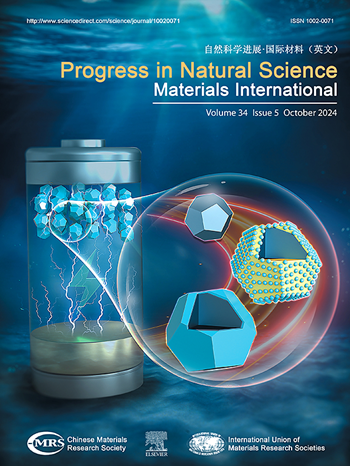Optimizing large optical contrast in Ge-Se-Te films via high-throughput method
IF 7.1
2区 材料科学
Q2 MATERIALS SCIENCE, MULTIDISCIPLINARY
Progress in Natural Science: Materials International
Pub Date : 2025-02-01
DOI:10.1016/j.pnsc.2024.12.012
引用次数: 0
Abstract
Chalcogenide phase-change materials (PCMs) have attracted great attentions due to their potential applications in reconfigurable photonic devices. The Ge2Sb2Te5 and GeTe PCMs exhibit significant difference in refractive index (Δn) between amorphous and crystalline states, but they suffer from high optical loss. The binary Sb2S3 and Sb2Se3 PCMs, however, show low optical loss but small Δn. This encourages us to develop the novel materials, which are desired to combine large Δn and low optical loss. Instead of traditional trial-and-error screening method, we here used an efficient high-throughput method to optimize the PCMs’ candidates for reconfigurable photonic devices in Ge-Se-Te chalcogenides. The crystallization temperature and difference in optical bandgap were detected, and then the component of Ge25Se7Te68, which also exhibits ultralow optical loss of 1.2 × 10−6 (in amorphous state) and large Δn of 1.32 at 1550 nm, was optimized. This Te-rich Ge-Se-Te film can be a candidate for the applications of programmable reconfigurable photonic circuits.
利用高通量方法优化Ge-Se-Te薄膜的大光学对比度
硫系相变材料因其在可重构光子器件中的潜在应用而备受关注。Ge2Sb2Te5和GeTe PCMs的折射率(Δn)在非晶态和晶态之间有显著差异,但它们的光学损耗很高。然而,二进制Sb2S3和Sb2Se3 PCMs显示出低光损耗,但小Δn。这鼓励我们开发新型材料,希望结合大Δn和低光学损耗。代替传统的试错筛选方法,我们在这里使用了一种高效的高通量方法来优化用于Ge-Se-Te硫族化合物中可重构光子器件的PCMs候选材料。通过对晶化温度和光带隙差异的检测,优化了在1550 nm处具有1.2 × 10−6(非晶态)的超低光损耗和1.32的Δn大光损耗的Ge25Se7Te68元件。这种富te的Ge-Se-Te薄膜可以作为可编程可重构光子电路的候选材料。
本文章由计算机程序翻译,如有差异,请以英文原文为准。
求助全文
约1分钟内获得全文
求助全文
来源期刊
CiteScore
8.60
自引率
2.10%
发文量
2812
审稿时长
49 days
期刊介绍:
Progress in Natural Science: Materials International provides scientists and engineers throughout the world with a central vehicle for the exchange and dissemination of basic theoretical studies and applied research of advanced materials. The emphasis is placed on original research, both analytical and experimental, which is of permanent interest to engineers and scientists, covering all aspects of new materials and technologies, such as, energy and environmental materials; advanced structural materials; advanced transportation materials, functional and electronic materials; nano-scale and amorphous materials; health and biological materials; materials modeling and simulation; materials characterization; and so on. The latest research achievements and innovative papers in basic theoretical studies and applied research of material science will be carefully selected and promptly reported. Thus, the aim of this Journal is to serve the global materials science and technology community with the latest research findings.
As a service to readers, an international bibliography of recent publications in advanced materials is published bimonthly.

 求助内容:
求助内容: 应助结果提醒方式:
应助结果提醒方式:


